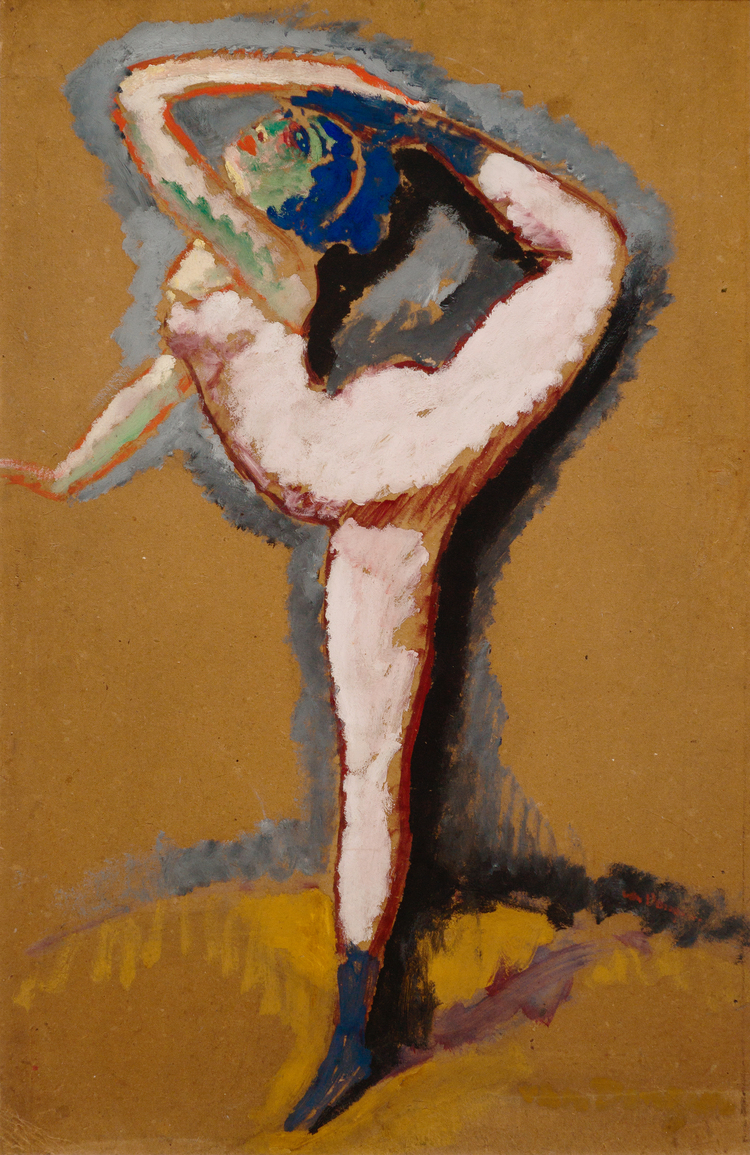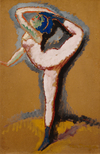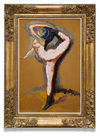C.T.M. (KEES) VAN DONGEN 1877 Delfshaven (The Netherlands) - 1968 Monte Carlo (Monaco) L'Acrobate
Oil / Board: 78.4 x 51.3 cm
- This artwork can be viewed in our gallery
- Call us for more information: +31 26 361 1876
- World wide shipping available
Details
Een acrobate komt naar voren in het voetlicht, haar lichtroze pakje licht op onder de felle schijnwerper. Met haar hand houdt ze haar voet vast achter haar hoofd, zodat haar lichaam een cirkel beschrijft. Het contrast met de schaduwpartijen is extra aangezet door die knalgroen te schilderen en het haar felblauw. De figuur is direct op het karton geschilderd en dat versterkt het gevoel van spontaniteit nog. Dit bijzondere schilderij is een schoolvoorbeeld van het Fauvisme: een kortstondige nieuwe stroming met enorme invloed op de moderne kunst in de eeuw die zou volgen. Het Fauvisme was spontaan en energiek, rauw, vol kleur, zonder diepte en volslagen nieuw. De Fauves braken radicaal met het impressionisme en maakten vorm en kleur los van de realiteit. De Nederlandse schilder Kees van Dongen was er een van de belangrijkste vertegenwoordigers van.
In 1905 toonde Van Dongen zijn werk op de Salon d'Automne, waar jaarlijks de allernieuwste kunst te zien was, samen met onder anderen Henri Matisse, André Derain en Maurice de Vlaminck. Een criticus vergeleek de schilders met wilde beesten (Fauves), waardoor de beweging zijn naam kreeg. De ophef was enorm, en de schilders waren op slag beroemd. Van Dongen onderscheidde zich van de andere Fauves doordat hij geen landschappen schilderde, maar zich uitsluitend richtte op de mensen die de Parijse theaters, cabarets en circussen bevolkten. Vooral vrouwen vormden zijn onderwerp: hij werd bij uitstek de schilder van de Parijse demi-monde. Hij schilderde ze met hun grote zwartomrande ogen en felrode mond, onmiddellijk herkenbaar als werk van de grootste Nederlands-Franse schilder van de 20ste eeuw. Kees van Dongen begon zijn carrière in Rotterdam, waar hij een paar jaar studeerde aan de academie. Hij schilderde in de trant van de Haagse School, maar koos zijn onderwerpen uit het rauwe leven in de stad en in de rosse buurt. Zoals veel kunstenaars ging hij regelmatig naar Parijs, maar Van Dongen besloot er definitief te blijven. Na een moeilijk begin ontwikkelde hij zich tot de beroemdste society-schilder van Frankrijk.
In de tijd dat Van Dongen dit schilderij maakte woonde hij in Le Bateau-Lavoir in Montmartre, een vervallen gebouw dat voor de Eerste Wereldoorlog een woonplaats en trefpunt was voor talloze schilders, schrijvers en dichters. Van Dongen ging er wonen in 1905, waarschijnlijk op uitnodiging van Pablo Picasso. Samen gingen ze regelmatig naar het Circus Medrano, dat vlak in de buurt was. Omdat ze er mochten werken tijdens de repetities en gratis toegang kregen bij de voorstellingen had dit circus een enorme aantrekkingskracht op kunstenaars. Al vanaf de bouw in 1875 was het een trefpunt voor de Parijse bohème. Auguste Renoir, Edgar Degas, Georges Seurat en Henri de Toulouse-Lautrec maakten er beroemde schilderijen en aan het begin van de 20ste eeuw was er een nieuwe generatie kunstenaars te vinden: Pablo Picasso, George Braque en Kees van Dongen waren er stamgasten. Een nieuwigheid moet de kunstenaars daar bijzonder hebben geïnteresseerd: het circus werd verlicht met elektrische lampen en er waren spotlights die de artiesten volgden. Van Dongen heeft hier het effect van zo’n schijnwerper geschilderd.
Width: 51.3 cm
Collection Ellen Melas Kyriazi, Switserland.
Sale: Habsburg, Feldman, New York, May 8, 1989, lot 31; Gallery Sakai, Japan.
Private collection, Asia (Acquired from the above circa 2000).
Sale New York (Sotheby's), 6 November 2015, lot 356 ill.
Van Fentener van Vlissingen Foundation, The Netherlands, 2015 - 2019 (acquired at sale above).
Art Gallery Albricht, Oosterbeek, The Netherlands.
Paris Musée Jacquemart-André, Le Bateau Lavoir, 1975 no. 13
Lausanne galerie Vallotton, Van Dongen, September 1971 no. 9
Paris, Musée National d'Art Moderne / Rotterdam, Museum Boijmans Van Beuningen, Van Dongen, 1967-10-13 - 1968-01-28, no. 32, dated c. 1905-07
Laren, Singer Museum, "Painters of light. (Schilders van het licht)", September 2020 - January 2021
Saint-Tropez, Musée de l'Annonciade / Toulouse, Re´fectoire des Jacobins, Kees van Dongen 1877-1968, 1985-07-06 - 1985-11, no. 12
Jean Melas Kyriazi, Van Dongen et le fauvisme, La Bibliothèque des arts, Paris, 1971, no. 35, p. 87- dated 1906
Exhibition catalogue Monaco, Monaco National Musée Nouveau, Kees van Dongen, 2008-06-25 - 2009-04-19 (+ venues Montreal & Barcelona), fig 34, p. 175 - dated 1909-1910
Rotterdam, Museum Boijmans Van Beuningen, Kees van Dongen, 1989-12-17 - 1990-06-17, p. 40 BVG 8782 (L’Acrobate 1905-1907)
J.R. De Lorm, A. van Lienden, e.a., Singer Museum, "Painters of light. (Schilders van het licht)", Laren 2020, p. 50
J. Bellow, S. Biass-Fabiani, F. Blanchetière a.o., "Rodin and Dance", Musée Rodin and The Courtauld Gallery, 2017-2018, p.30, no. 15 (ill.)
Anita Hopmans, "Kees van Dongen. The Road to Succes", Laren/Zwolle 2023, p. 137, no. 84
No. 99.06.03.6413.691 Wildenstein /Platner Institute, New York
Over C.T.M. (KEES) VAN DONGEN
Cornelis Theodorus Marie van Dongen was a Dutch-French painter. He was part of the movement referred to as Fauvism. Other painters who belonged to this movement included Matisse, De Vlaminck, Bracque and Dufy. Characteristic of these artists is the use of bright unmixed colors. Born a Dutchman, Van Dongen spent much of his life in France and also obtained French citizenship.
Kees van Dongen was born in Delfshaven to a family of four children. His father owned a malthouse. The company was located next to the house where Kees grew up. At the front and back of the house was water. Through the window one had a view of the boats moored in the water. Kees had great talent for drawing. However, there was no money for a proper art education. From the age of fourteen, Kees had to work.
Between 1896 and 1898, he took evening classes at the Academy of Visual Arts and Technical Sciences (now the Willem de Kooning Academy). This was located on the edge of Rotterdam's red light district where many sailors came. The sailors, prostitutes and dancers were the subject of many of Van Dongen's works. It was a lively neighborhood with coffee houses, brothels, candy stalls, in short an exciting environment for an aspiring artist.
In 1897, twenty years old, Van Dongen left for Paris. There he could barely support himself. He stayed in the studio of the painter Siebe ten Cate in Montmartre. After returning briefly to Rotterdam from 1898, where he devoted himself to illustrations for the Rotterdams Nieuwsblad, Van Dongen settled permanently in Paris from 1900. There he initially occupied himself with drawing and illustrating magazines. His fluent drawing style effortlessly transitioned into a style of painting that brought him into the milieu of the French Fauvists. This movement first showed its work at the 1905 Salon d'automne, where work by Kees van Dongen was also on display.
Fauvism was a new phenomenon for that time. It was a much more expressive way of painting than had been practiced until then. Especially the use of pure unmixed colors is characteristic of the fauvists. Van Dongen found himself in Paris among the French and developed his own identity. His work is not so much French-oriented, like that of his Parisian colleagues, as it is internationally oriented. He visits Spain, Morocco, Tunisia, Egypt and the Netherlands. His work therefore differs from the more nationalistic cubist art of the French. Van Dongen's work is clearly influenced by the different cultures he has become acquainted with.
Once settled in Paris, Van Dongen moves into a large studio in Montparnasse, where he not only receives his art friends but also organizes dance parties. By now he has become a celebrated artist. The cultural life ended during the First World War. After this war ends, life in Paris picks up full speed and Van Dongen manages to draw attention to his work.
He creates large portraits of people from the world of film and theater with which he achieves great success. Van Dongen moves into an even larger studio. The parties and celebrations he gives there play an important role in the way he presents himself as an artist. He is at the height of his fame and is enjoying this life. He has commissions to choose from. In 1929 he becomes a naturalized Frenchman. In the 1920s, he painted mostly portraits in the fashionable circles of Paris. By now Van Dongen had become more French than Dutch.
During World War II, Van Dongen tried to continue painting as much as possible. He did not care too much about the circumstances. Even after the war, he remained active as a painter, while also continuing to create graphic work. He lithographed and illustrated many books. Van Dongen remained active as an artist until an advanced age and participated in nightlife.
Today his work, in addition to private collections, can be found at Museum Boymans-van Beuningen in Rotterdam, Haags Gemeentemuseum, Stedelijk Museum in Amsterdam and Stedelijk van Abbe Museum in Eindhoven.
If there is one subject that is part of Van Dongen's work it is "women. He called women "the most beautiful landscape. His drawings of girls from Rotterdam's red light district caused a scandal. Works of naked women were removed from an exhibition at Boymans-van Beuningen in 1949 because of the uproar over them. He painted Picasso's girlfriend and made lithographic posters of Brigitte Bardot. He often portrayed women in bright colors and with big eyes. His nudes also became very famous.




